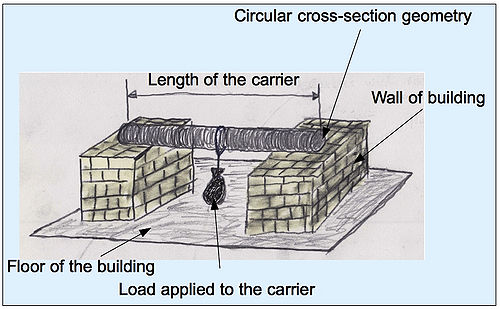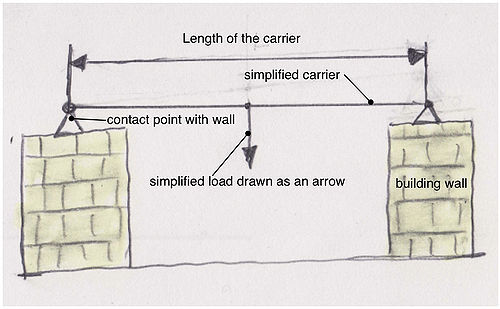Difference between revisions of "What Are Reasonable Spans of Carriers made of Various Materials"
HTP Petros (talk | contribs) |
HTP Petros (talk | contribs) |
||
| Line 15: | Line 15: | ||
Remember: '''NEVER''' use concrete or similar materials without reinforcements of steel or similar for a carrier! The possibility that it will colappse is almost certain! | Remember: '''NEVER''' use concrete or similar materials without reinforcements of steel or similar for a carrier! The possibility that it will colappse is almost certain! | ||
| + | ===The geometry=== | ||
[[Image:Profiles.jpg|thumb|center|500px|Figure 3: An overview of the most common carrier crossections]] | [[Image:Profiles.jpg|thumb|center|500px|Figure 3: An overview of the most common carrier crossections]] | ||
Revision as of 15:15, 14 January 2010
At this part of howtopedia simple methods are presented of how you can calculate if you have selected a reasonable span for your carrier used for building a roof or to hang different objects on it. For this purpose a simple example of a carrier which connects one wall of the house with the other as can be seen in figure 1 is presented. For simplicity the carrier is loaded in its middle with a sandbag. Exactly the same loading would be present if the roof was mounted at this point.
For reasons of simplifying future calculations and understanding the above figure 1 is remade and represented as in figure 2
For the start it is Importatnt to remember that the allowable span which a carrier can have so that it will not collapse depends on three important factors:
+ its cross-section geometry (see examples in figure 3 below)
+ its material (steel, wood or reinforced concrete)
+ on how you will apply the load on it (is the weight in the middle of the carrier or at an other point)
Remember: NEVER use concrete or similar materials without reinforcements of steel or similar for a carrier! The possibility that it will colappse is almost certain!
The geometry
Notice that from the above mentioned cross-section geometrys the best choice conserning the weight of the carrier and its resistance to the loading in our case would be to use the "H-shaped" cross-section as for instance one can find in railroad tracks. Never the less it is more probable that you will find tree stems or wooden carriers with round or rectangular cross-section that also do the job very good.
As you may have experienced yourself every material has a certain strength. For instance if you take to rods of the same diameter one of wood and one of metal you will see that to brake the wooden stick in two need much less effort than for that of the metal. So the same carrier of metal will for sure be able to resist to a much higher load than a wooden one. This phenomenon is described using a number for each material (called yield stress). For instance for metal a value of 200 MPa. MPa is a unit to measure this phenomenon (like meters or hours would be for length and time)
to be CONTINUED........ Notice: The author accepts no responsibility for the safety of a construction or the correctness of the article


